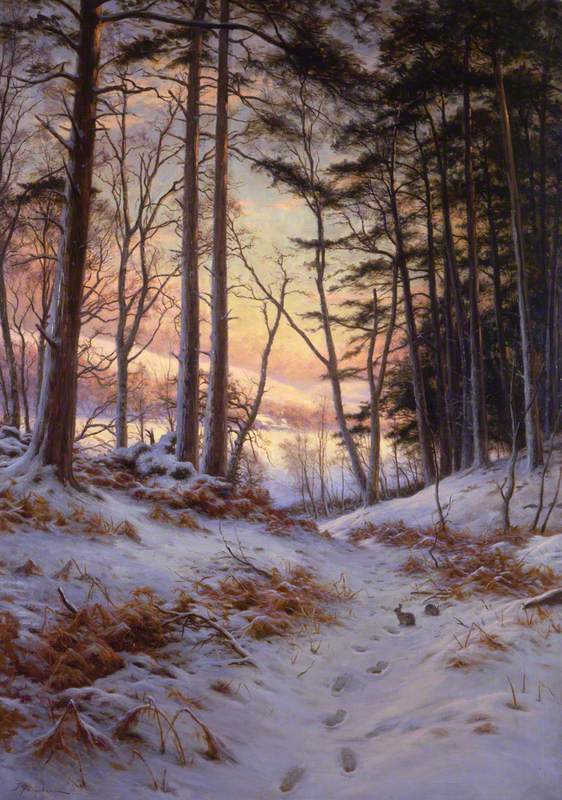Winter has always been a source of inspiration for many painters, and at a time when winter covers cities with snow and frost, winter itself is covered in the popular imagination with many moments of joy and celebration.
Many of the painters immortalized the winter in their work, sometimes through realistic scenes of cities and forests after they became white by the snow.
And at other times, in the light of the golden rays of the sun that shine on this white, some of it gradually melts.
However, the painters' great emphasis was on conveying the spirit of winter and the aspects of celebration and joy that accompany it, although this was not the case at first.
Winter before the 15th century was not a significant subject, as the religious wars in Europe between Catholics and Protestants caused the dominance of religious subjects in painting.
Even the few paintings that were not set in a religious context, were intended to highlight the genius and inimitable talent of the painter.
With the advent of the Renaissance and the twentieth century, artistic subjects witnessed a great diversity due to the prevalence of new intellectual doctrines, which was reflected in art.
The plastic art schools themselves varied between realism, impressionism, surrealism and others.
Winter and landscape paintings have had the lion's share of that diversity.
The philosophy of the return to nature and the rule of mind had the greatest influence in shaping the new Europe.
From the 15th century until the middle of the 20th century, winter was a guest in hundreds of paintings, and the representation of winter reached its climax with the Impressionist school by the pioneer of the French painter Claude Monet.
White paralysis
In 1564, Europe experienced one of the coldest winters in its history until it was called the "Little Ice Age".
In that winter the land fell, crops were lost, rivers froze, water became scarce, and a famine erupted, causing widespread looting.
The same thing was repeated until the 18th century.
The Little Ice Age had a profound effect on all life in Europe.
And although it was a disaster, someone took advantage of it remarkably well.
That person was the Flemish-Dutch painter Pieter Bruegel the Elder (1525-1569), who during this period painted the first panoramic view of his village completely covered in snow.
This was the first painting that dealt with winter as a theme, "Hunters in the Snow" in 1565, and it marked a revolution in plastic art, as it contradicted the prevailing tradition in past centuries which was about drawing religious subjects.
Today it is one of the most famous landscape paintings in the entire world.
The Little Ice Age has left a profound impact on all forms of life in Europe (social networking sites)
The painting illustrates the contrast between the stark nothingness that the village lives under the ruins of the ice and the movement of life that does not freeze no matter what.
On the left over the hill, there is the return of 3 hunters from an expedition accompanied by their emaciated dogs, and the carcass of a small fox indicates the scarcity of hunting due to the death of most of the animals.
There are also women who burn some wood to keep warm, the sky is cloudy, the colors are silent and cold, the trees are without leaves, and in the valley below the hill a number of people skiing on ice, in a movement that contradicts the inertia imposed by the snow, as a symbol of the victory of human instincts in survival.
Contoured snow
In his painting "Twilight", 1912, the Scottish painter Joseph Farquharson (1846-1935) presents a landscape of Scotland's forests covered in twilight snow with rabbits running among the plants.
In contrast to the brutality of Winter in Bruegel's painting, Winter in Farquharson's paintings appears tender, calm, and bearable.
Painting "Twilight" by Scottish painter Joseph Farquharson (social networking sites)
"It's a very romantic image of a sunset, snow, river and mountains, the Farquharson landscape was all about the mood," says Griffin Coe, curator of the Aberdeen Art Gallery.
Farquharson excelled at capturing a sense of warmth and serenity.
His paintings had unusual titles and were sometimes inspired by the poems of Burns, Milton and Shakespeare by virtue of his fondness for English literature.
Of course, the landscapes of Scotland were a generous source of inspiration for him.
Creamy winter
Winter has reached its zenith by the French painter Claude Monet (1840-1926), when he painted 140 paintings in love with Snow White, the most famous of which is "The Magpie", which he painted during the winter (1868-1869) on Impressionism.
The painting depicts a magpie standing on a wooden fence on a farm near the municipality of Etretat, Normandy.
"The painting is an unusual evocation of the cold snow in a winter afternoon. The blue of the tall shadows creates a subtle contrast to the whites of the sky and creamy landscapes," says Lynn Orr, curator of the San Francisco Museum of Fine Arts.
The use of colored shades was unknown before Monet, and he is credited with introducing them into painting, and the leadership of Impressionism as a whole is credited to him.
Several painters, such as Vincent Van Gogh and Camille Pissarro, included it in their works, until after that it became one of the defining features of Impressionism.
Thus, winter appeared in various forms in plastic art, and it was on the throne of paintings after centuries of absence.
Although it was a source of joy for many in the modern era by virtue of the availability of means of protection, winter until the 18th century was a symbol of death, hunger and deadly inertia.

